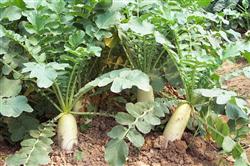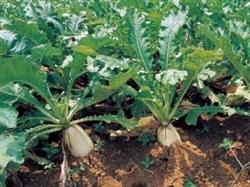Key points of cultivation techniques of spring radish

First, the selection and preparation of land is convenient for drainage and irrigation, the soil quality is better, and the land with medium and high fertility should be planted uniformly, leveling the field in autumn, irrigating well winter water, raking to preserve soil moisture many times in winter and spring, and picking up stubble. Second, the total belt spacing of planting specifications is 225 cm, in which the net belt of wheat is 133 cm, double rows rely on, 12 rows of wheat are planted, the width of corn is 92 cm, 3 rows are planted, the row spacing is 26 cm, the plant spacing is 18-20 cm, and the distance between two rows of corn is 20 cm. Soybeans are interplanted between corn and wheat side rows, plant spacing is 30 cm, and each wheat belt is planted with 2 rows of perilla seeds in the middle wide row. 3. Cultivation techniques 1. Selection of improved varieties: seeds are required to be selected, seeds for production must be full, purity not less than 96%, purity not less than 98%, germination rate not less than 85%, moisture content not less than 13%, grain is strictly forbidden to replace seeds, corn is all coated seeds, perilla seeds are selected with full seeds. 2. Sowing at the right time: wheat should be sowed early at the end of February and early March, corn should be sown on April 10-15, soybean should be sown around April 20, and perilla seed should be sowed before the wheat drips. 3. Sowing rate and density: 19-20kg per mu of wheat, 34-360000 per mu of seedlings, 33-350000 of harvested ears and 3.03.5kg of corn per mu. After the seedlings were fixed, there were 4400-4500 seedlings per mu, 3000-4000 seedlings per mu of soybean, 1 kg per mu of seed sowing and 1-12000 seedlings per mu. 4. Fertilization ⑴ base fertilizer: 5000 kg of farm manure is applied per mu, formula fertilization is recommended for chemical fertilizer, 50 kg of ammonium bicarbonate, 50 kg of common phosphorus, or 30 kg of granular phosphate fertilizer are applied per mu, preferably in autumn. ⑵ seed fertilizer: 12.5kg of diammonium phosphate per mu when sowing wheat and 6kg of diammonium phosphate per mu when sowing corn. ⑶ topdressing: before irrigation of ① wheat in late April, urea was applied to 10-12.5kg per mu. ② corn topdressing for 3 times, combined with wheat irrigation. Seedling fertilizer around May 20, 10-12.5 kg urea per mu; panicle fertilizer in late June, 25-30 kg urea or 60-70 kg ammonium bicarbonate per mu; grain fertilizer 10-15 kg urea or 30-40 kg ammonium bicarbonate per mu in mid-July (after wheat harvest). ③ Suzi is divided into 3 times of topdressing: early topdressing of seedlings after wheat harvest and 5 kg of urea per mu. From the end of July to the beginning of August, we applied 5-10 kg urea per mu and 2.5-5 kg urea per mu when flowering. 5. Irrigation time: the first time in late April, the second in early May, the third in late May (maize seedling fertilizer), the fourth in late June (corn ear fertilizer), the fifth in mid-July (corn grain fertilizer), the sixth in late July and early August (Suzi topdressing), and the seventh from late August to early September. 6. Control of diseases, insect pests and weeds ⑴ weeding: mainly to remove dicotyledonous weeds in wheat fields. Before soybean emergence at the end of April, the mu was sprayed with 40 grams of 72% 2helium 4murine D butylfat EC and 30 kg of water. ⑵ pest control: ① aphids, pay close attention to the pest situation, the number of aphids of 100 aphids at jointing stage is 5, the number of aphids of mixed population at booting stage is 50, when the number of aphids is 250 at heading stage, 10-15 grams of anti-aphid powder is used per mu, or 2.5% enemy kill or 20% butyl EC 10-15 ml, 30-40 kg water spray. ② armyworm, 50-100ml with 50% phoxim per mu, or 10-15ml with enemy kill or quick-kill, 30-40kg spray with water. ③ corn borer must clear last year's corn straw by the end of April. In the big trumpet period (late June to early July), each corn plant is infused with 3-5 grams of poisonous soil or venom. The medicament can be filled with 10-15 milliliters of kung fu EC and 8-15 milliliters of Lefuling, and 20-30 kilograms of sand or furnace ash and venom can be used for soil mixing. ④ Red Spider, 50 ml omethoate EC 50 ml plus 20% dicofol EC 50 ml per mu, or 75-100ml Nisorone EC (wettable powder) 75-100ml per mu, or 20% methotrexate EC 50 ml per mu, 30 kg per mu spray, 2-3 times in total, once every 10-15 days. ⑶ disease control: ① wheat powdery mildew: 20% diseased leaves at booting stage and 10% diseased leaves at flowering stage. Spray 40 grams of 20% strychnine per mu, or 30 grams of 25% strychnine with 30-40 kg of water. ② wheat rust: the diseased leaf rate before heading is up to 2% for control, and the drug is the same as powdery mildew. ③ wheat scab, 50 ml carbendazim glue suspension and 30-40 kg water spray were used at the initial heading stage. 7. Wheat should be harvested at the end of wax ripening as early as possible. Corn must be harvested at the end of September when all the leaves are white, the leaves turn yellow and dry, and the grains are glossy and hard. Soybean leaves turn yellow and pods are harvested when they harden. Perilla seed is easy to drop grains and should be harvested as soon as possible in the mature period.
- Prev

Cultivation and Management techniques of Carrot sowing in Spring
The growth temperature of radish ranges from 6 to 25 degrees Celsius. At present, the varieties of winter and spring radish are widely used, such as Korean New White Yuchun, Baiguang Spring Baiyu and so on. The soil should choose sandy loam with loose soil, fertile soil and good permeability. Fully mature organic fertilizer and compound fertilizer should be applied before sowing, usually 45000 to 45000 per hectare.
- Next

Management techniques of spring radish in May
Planting spring radish in early spring is a way to get rich with small investment, short cycle and high benefit. It can not only supplement the off-season supply of vegetables and increase the variety of flowers and colors, but also provide a good stubble for later cropping. The main cultivation techniques are introduced as follows: 1. The selection of good varieties should generally choose high yield and quality.
Related
- Where is it suitable to grow horseradish in China? it is expected to see the middle altitude horseradish in Alishan.
- How to prevent tomato virus disease reasonably? (Control methods included)
- Many people like to plant towel gourd on the balcony. What are the main points of this method and management?
- What crops can chili peppers be mixed with?
- Fertilization techniques and matters needing attention in Tomato
- What are the grafting techniques for peach seedlings in spring?
- Harm and control methods of root swelling disease of Chinese cabbage
- What are the pests of sweet potatoes? How to prevent and cure it?
- Symptoms, causes and Control methods of navel Rot in Tomato
- The cause of "Cucumber rotten bibcock" in Farmers' planting Cucumber and its Control Plan

